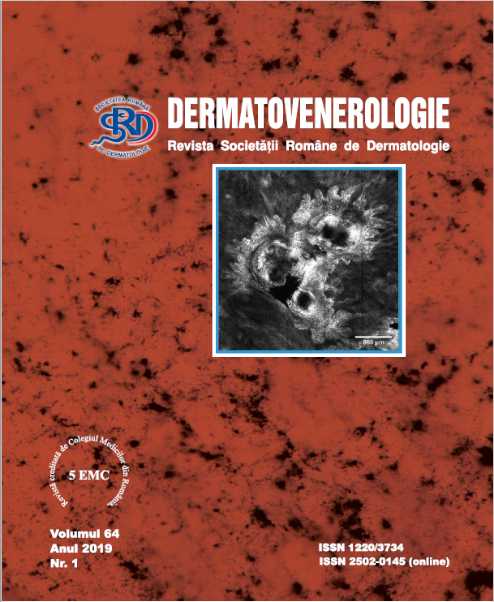Rezumat
Radiodermita este o consecinta nefasta a radioterapiei,
ce poate sa apara in perioada iradierii (radiodermita acuta)
sau dupa cateva luni, uneori chiar ani de la incheierea
acesteia, in acest caz fiind vorba despre radiodermita cronica.
in continuare vom prezenta cazul unui pacient cu mai
multe carcinoame bazocelulare, aparute pe fondul unei
radiodermite cronice atenuate, secundara radioterapiei
unei pilomicoze, la varsta de 6 ani.
Caz clinic
Pacient in varsta de 59 ani, din mediul urban, s-a
spitalizat in clinica de Dermatologie Craiova pentru
prezenta unor formatiuni tumorale la nivelul scalpului.
Examen dermatologic: in regiunea parietala, se
evidentiaza 2 placi eritematoase, infiltrate, usor elevate, cu
descuamare fina si dimensiuni de pana la 1 cm. in regiunea
occipitala se evidentiaza o formatiune tumorala rotunda,
bine delimitata, cu diametrul 2 cm, elevata 1 cm, de
culoarea tegumentului. in regiunea temporala, pacientul
prezinta o formatiune tumorala, bine delimitata, diametru
1/2 cm, usor elevata, de culoare bruna.
Discutii
Radiodermita este o afectiune a pielii si tesutului
subcutanat, determinata de actiunea locala a radiatiilor
ionizante.
Incidenta radiodermitei cronice nu este pe deplin
cunoscuta, dar se estimeaza ca aproximativ 95% dintre
pacientii supusi radioterapiei vor prezenta o anumita forma
de afectare cutanata.
Patogeneza este reprezentata in principal de
perturbarea echilibrului dintre citokinele proinflamatorii si
cele profibrotice.
Manifestarile clinice ale radiodermitei cronice includ
telangiectazii, hipo si hiperpigmentari neregulate, atrofie
cutanata si cicatrici.
Tratamentul radiodermitei cronice si al carcinoamelor
radioinduse este complex, implicand atat metode
chirurgicale, cat si metode nechirurgicale, reprezentate de
terapie farmacologica, fizioterapie, laserterapie etc.
Concluzii
Radiatiile ionizante administrate in scop terapeutic
cresc riscul aparitiei cancerelor cutanate.
Expunerea la ultraviolete potenteaza efectul radiatiilor
ionizante, crescand riscul de aparitie a carcinoamelor
cutanate.
Radioterapia utilizata pentru tratamentul pilomicozei
in copilarie are efecte indezirabile pe termen lung, unii
pacienti dezvoltand carcinoame bazocelulare la nivelul
scalpului.
Timpul scurs intre efectuarea radioterapiei si aparitia
carcinoamelor bazocelulare este in medie de aproximativ 50
de ani la majoritatea cazurilor descrise in literatura.


